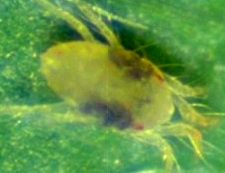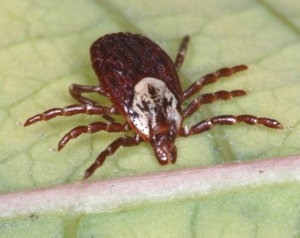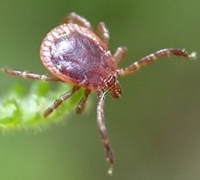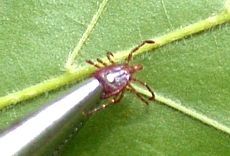|
|
ARTHROPODS:
Insects»
Spiders»
Centipedes»
Millipedes»
Sowbugs»
Harvestmen»
Mites
& Ticks»
Scorpions»
Identification
Tips»
About
the Critter Files»
Links» |
|
|
|
KENTUCKY
MITES & TICKS
Critter
Files/Mites & Ticks
By
Blake Newton
University of Kentucky, Department of Entomology
| Common
Kentucky Mites & Ticks: |
|
|
|
|
|
|
|
|
|
|
|
|
|
|
|
|
|
| |
| TAXONOMY |
KINGDOM: Animalia
| PHYLUM: Arthropoda | CLASS: Arachnida | ORDER: Acari (mites) |
| |
WHAT
IS A MITE?
LIFE CYCLE
ECOLOGY
PEST STATUS
COMMON KENTUCKY MITES
COLLECTING & PHOTOGRAPHY
MITE FACTS
MYTHS, LEGENDS, AND FOLKLORE |
| |
| WHAT
IS A MITE? |
|
Like all arachnids,
mites and ticks have 4 pairs of legs, pincer-like mouthparts called
"chelicerae," 2 antennae-like appendages near the mouth
called "pedipalps," and no antennae. Although all
arachnids have 2 main body segments (cephalothorax and abdomen),
on mites and ticks the segments are fused and appear to be 1 large
segment. Like spiders and most other arachnids, adult mites have 8 legs, while some immature stages have 6 legs.
Okay, So What
is a Tick?
A tick is a type of mite: the word "tick" is used to describe
large, parasitic mite species that attach themselves to hosts for
several days at a time.
|
|
| SIZE:
Most mites are very small (less than 1/10"). Some ticks can grow
to about 1/4". |
| |
| LIFE
CYCLE |
|
Like all arachnids,
mite and ticks have incomplete metamorphosis. Young ticks and mites
hatch from eggs and resemble tiny adults, although newborn immature stages have 6 legs instead of 8. They shed their
skins as they grow.
|
| |
| ECOLOGY |
|
Although they are not
noticed as often as some of their arthropod relatives, mites are
very common and occur in many different kinds of habitats. The
most common kinds of mites live in soil and feed on debris. Other
kinds feed on plants, and some are predators. There are many
mite species that are fully aquatic.
Many common species of
mites are parasitic, living off the blood and tissues of larger
animals. There are parasitic mites that live on just about
any kind of animal imaginable, everything from fish to insects.
Chiggers are a well-known type of parasitic mite that sometimes
attacks humans. Ticks are types of mites, and all ticks are
parasites. |
| |
| |
| COMMON
KENTUCKY MITES |
|
|
MITES |
|
Although
mites are everywhere, most are too small to see. However,
there are few kinds that are fairly large and frequently encountered
in Kentucky.
Pictured below left is
the Two-Spotted Spider Mite, Tetranychus urticae,
a common pest on a variety of plants. On the right is a red
velvet mite, a predator. These large (1-3 mm), bright red
mites are sometimes seen crawling on trees (below). Young
velvet mites are parasites on insects, and the adults are predatory
on small arthropods.
We also have a number
of aquatic mites that are common in Kentucky streams. Some
of the aquatic mites are also relatively large and bright red. Most
aquatic mites are either predators or parasites of aquatic insects,
and they are very good swimmers. |
| |
 Two-Spotted Spider
Mite (R. Bessin, 2000)
Two-Spotted Spider
Mite (R. Bessin, 2000) |
 Red Velvet Mite
(B. Newton, 2004)
Red Velvet Mite
(B. Newton, 2004) |
|
 Red Velvet Mites
on tree trunk (B. Newton, 2005)
Red Velvet Mites
on tree trunk (B. Newton, 2005) |
|
|
|
| TICKS |
|
| Pictured below
are 2 common ticks commonly found on people and pets, the American
Dog Tick, Dermacentor variabilis, and the Lone
Star Tick, Amblyomma americanum. Learn to
recognize these important pests. Thanks to Dr. Michael Dryden,
Professor of Veterinary Parasitology, Department of Diagnostic Medicine/Pathobiology at Kansas State University for helping to correct our identifications, and for sending us the dog tick image below. |
| |
 Dog Tick Female, Dermacentor variabilis (Dr. Michael Dryden, 2005)
Dog Tick Female, Dermacentor variabilis (Dr. Michael Dryden, 2005) |
|
 Male Lone Star
Tick, Amblyomma americanum
Male Lone Star
Tick, Amblyomma americanum
(B. Newton, 2003) |
 Female Lone Star Tick, A. americanum
Female Lone Star Tick, A. americanum
(B. Newton, 2003) |
|
| |
| COLLECTING
& PHOTOGRAPHY |
|
Many small mites can
be collected quickly using "Berlese Funnels." Click here
to see how to make a Berlese funnel to collect mites and other arthropods
that live in soil and leaf litter. Finding most other kinds
of mites requires luck and patience, and searching in the correct
habitats. Because mites are small, photography can be a challenge.
Make sure you have plenty of light and a macro lens. Mites
and ticks should be preserved in alcohol.
|
| |
| MITE
FACTS |
|
Mites are sometimes blamed
for itches and bites that they are not actually responsible for.
Occasionally, people who work in office buildings begin to
notice rashes or itchy spots that seem to have no explanation. These
irritations resemble bites and the cause is often assumed to be
some sort of mite, probably because mites can be incredibly small
and can live in the strangest of places, and do sometimes bite people.
Often though, the real culprit is insulation, paper shreds,
or other contaminants spread through the building ventilation systems.
Chigger bites are sometimes mistaken for the bites of bed bugs. The confusion may occur because the symptoms of a chigger attack develop hours after the bite - many times when the victim is in bed! Bed bugs bites have very different symptoms, however. Read more about bed bugs in ENTfact 636 - Bed Bugs. And read about other strange
itches caused (and not caused) by arthropods in our Invisible
Itches ENTFact.
|
| |
| MYTHS
- LEGENDS - FOLKLORE |
|
Many of the methods
recommended to remove ticks are not effective. Petroleum jelly ,
matches, nail polish remover - none of these things are useful for
tick removal. Be sure to read our factsheet on Ticks
and Diseases for the best ways to deal with ticks.
|
Original document: 25 May 2004
Last updated: 6 May 2010
Photos courtesy R.
Bessin and B. Newton, University of Kentucky
The Kentucky Critter
Files are maintained by Blake Newton, Department of Entomology, University
of Kentucky.
Contact: blaken@uky.edu
|
|

